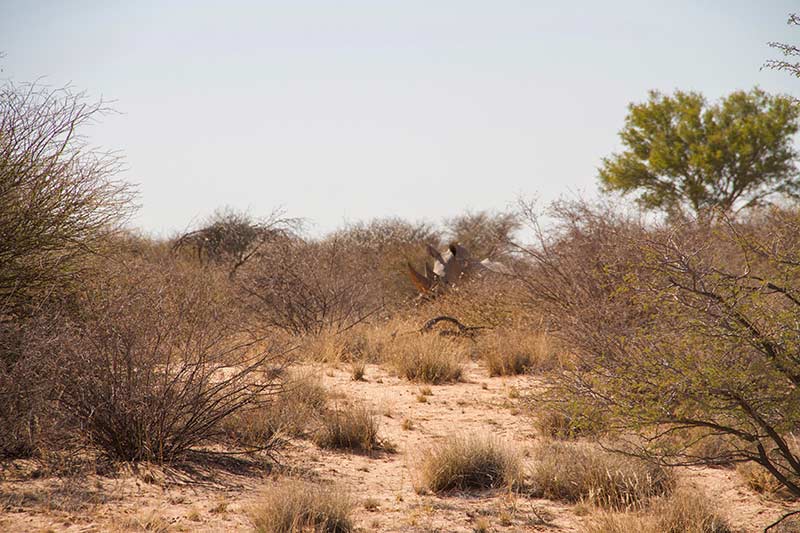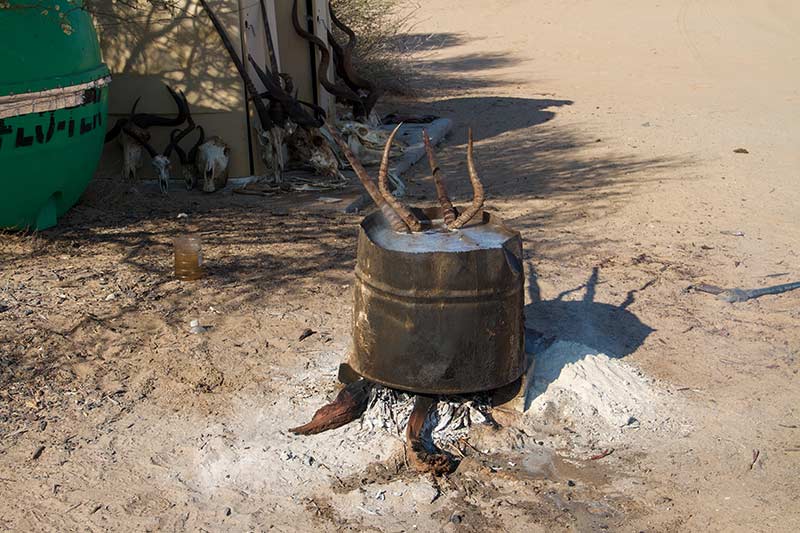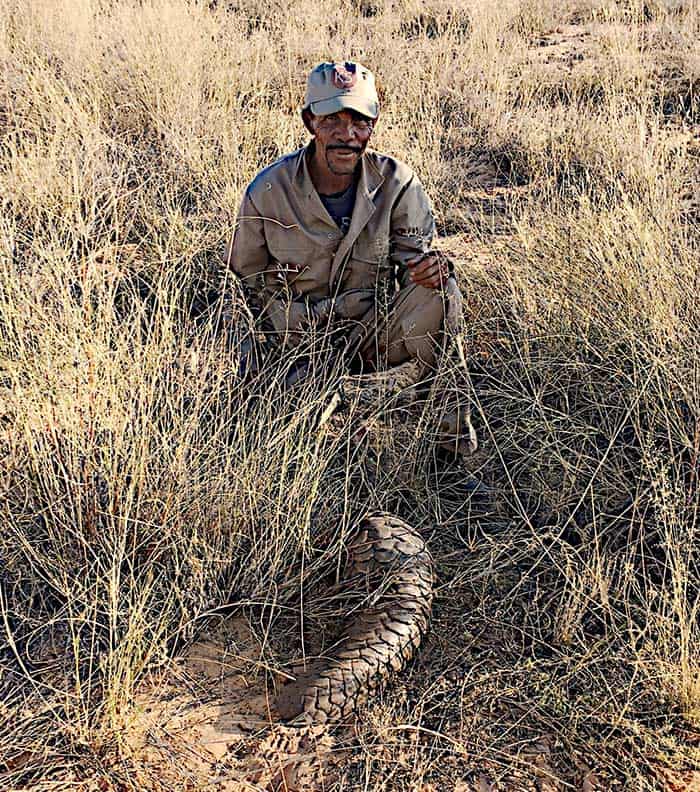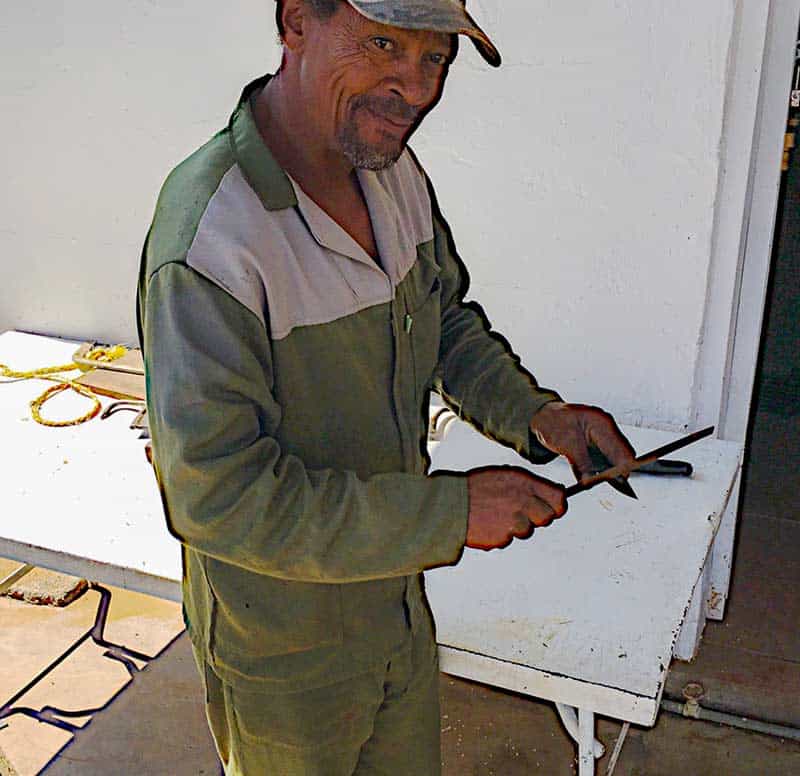Coyote 650 yards 243 Win
WRITTEN BY JEFF “TANK” HOOVER
I’ve just finished playing fetch with my wild woman of a mixed breed mutt, Maisie. It’s 24 degrees out with a 20-mph wind to emphasize just how chilly it is. It’s the end of January, the Holidays are nothing but blurred memories, yet we’re all still dealing with this damn Pandemic! Like you, I’m sick of it and am more than ready to for things to get back to “normal,” whatever that may be.
During these times, I return to my happy place — deepest, darkest Africa. It’s been 17 months, but I’m ready to be fascinated, enthralled and simply amazed at the wonderful wildlife, people and beauty Africa has to offer. For there, the world is as close to being in its original form as when planet Earth came into existence.
Being there makes you feel more connected to nature than any other place on the planet. Why? I’m not sure, but it’s one of the mysteries captured by so many who’ve experienced the Dark Continent. Perhaps it’s seeing the vast variety of animals, in their natural environment, witnessing their struggles for survival, seeing firsthand how the food chain really works and how harsh nature can be?
Sunrises and sunsets give new meaning of how beautiful life is. Being in the bush, far from civilization, magnifies the meaning of star-filled nights, gazing at the Southern Cross, while sitting around a cozy fire, favorite beverage in hand. This is Safari.
Because of effective game and land management, the animals are much better off and thriving. Management is funded by people who choose to experience and hunt these animals, as man has done since the beginning of time.
Countrys that have banned hunting have no funds for management and far smaller animal populations, some to the point of near extinction. One thing’s for certain, conservation works, and it can’t work without hunting.
I’ve picked some photos to share if you feel the need to escape, or answer Africa’s call yourself. Like anything in life, pictures are a far cry from experience, but they are better than words.
So, sit back and enjoy some of my favorite moments while in Botswana. Hopefully, you’ll feel the heat and dust in your eyes, smell the dung of a wildebeest herd, mixed with the flowery sweetness of blooming mellifera, feeling every bump riding in the bakkie, Land Cruiser, and lastly, feeling contentment from experiencing such a wonderful place as you enjoy the pictures.
To experience this adventure firsthand, check out Kudu-Safaris.com
You never know what’s going to pop out of the acacia brush.

Vietnam was really America’s last wild west war. There were a variety of reasons for this. The conflict dragged on for more than a decade, and American troops rotated through the combat zone by the hundreds of thousands.
The place was already awash in weapons before we got there, and there were new technologies aplenty that were evolving on the battlefield. Also, unlike modern war, not just everybody had a camera. All that conspired to grant US combat troops a bit more latitude in personal weapons than might otherwise be the case. In few places were these proclivities more overtly manifest than among Army aviators.
Vietnam was also the world’s first helicopter war. Vertical envelopment was the term du jour, and it did indeed change the way men did battle. Previously war was defined by set lines distinguishable on a map.
However, thanks to the widespread use of rotary-wing aviation in Vietnam, the front lines became wherever ground force commanders chose to make them. Any competent historian would agree that the UH1 Huey helicopter exemplified the conflict in Vietnam more than any other single war machine.
Variety is the Spice of Life

Helicopter tactics evolved substantially during the course of our involvement in Southeast Asia. At its apogee, Army Aviation consisted of four interrelated disciplines. While the crews all came from the same source material, how they did their respective jobs differed widely.
The primary assets in lift companies were indeed UH1H Hueys. These workhorse aircraft could theoretically carry up to 12 combat troops along with a 3-man crew though practical performance was also driven by environmental conditions and equipment loadout. Hueys were roomy, versatile, and cool. Everyone who has ever flown one loves the thing.
The heavy lift mission was undertaken by the CH47 Chinook and the CH54 Tarhe. The CH54 was more commonly known as the Skycrane. While there were four dedicated gunship versions of the Chinook in theater and the Skycrane could drop massive “Daisy Cutter” parachute bombs, these enormous cargo aircraft mostly kept forward units supplied in spaces that were otherwise inaccessible to more conventional transport.

Early attack helicopters were ad hoc machines improvised from Huey airframes. These pioneering Huey Hog gunships packed quad M60 machineguns, 2.75-inch folding-fin aerial rockets, and 40mm automatic grenade launchers.
Subsequent dedicated AH1 Cobra gunships utilized quite a few common Huey mechanical components but added tandem seating and M134 electrically-powered miniguns to the mix.
The aeroscout mission was serviced by OH6 and OH58 Light Observation Helicopters. Universally known as the Loach, the OH6 was the most common scout aircraft in theater.
Typically crewed by a single pilot and crew chief, Loaches typically packed an M134 minigun on the left side of the aircraft along with an M60 on a bungee cord on the right for the crew chief. The Loach mission was to get down in the dirt to root out hidden NVA and Viet Cong that could subsequently be addressed via associated gunships, fast mover attack jets, or artillery. Loach crews fought with machineguns, grenade launchers, hand grenades, small arms, and, occasionally, pistols.

Operating as they were in such intimate confines with the enemy, Army helicopters got shot down quite a lot. We lost more than 5,000 of the machines by war’s end. Many veteran Army aviators survived being shot down multiple times. This made the issue of personal defense weapons critically important.
Make Do with What You Have
Some Army helicopters are roomier than others. I have personally flown OH58’s, Hueys, Cobras, and Chinooks myself. Each machine has its own personality. The CH47 has plenty of room and power to burn.
You more wear the OH58 than fly it, but the old A-models seemed fairly underpowered. Hueys are like flying RVs with ample space and a forgiving personality. There wasn’t enough ancillary room in the Cobra cockpit to stow your flight jacket. The nature of the machine and the mission typically drove the weapons.
As the war progressed, there were seldom enough specialized aircrew guns to go around. In a war zone filled to bursting with firearms, this resulted in a lot of variation in defensive iron. I have known Vietnam veteran pilots who carried captured weapons, WW2-surplus ordnance, and even handguns shipped from home.
Recommended

The M1911A1 .45 automatic pistol was the standard-issue US Army sidearm in Vietnam. However, the single-action design did not readily lend itself to one-handed operation. Downed aircrew might conceivably have an injury that precluded use of both hands or they might be otherwise indisposed with some aircraft system or other.
As a result, single action/double action .38-caliber revolvers were the most commonly-encountered sidearms for Vietnam-era helicopter pilots. These were often WW2-surplus Smith and Wesson Victory models.
M1911’s were ubiquitous and available. Many aircrew therefore still opted for John Browning’s big manly handgun.
I have also heard of Lugers, P38’s, Colt Peacemakers, and similar vintage weapons finding their way into aviators’ holsters. Hugh Mills, author of the seminal work on Vietnam aviation Low Level Hell and every scout pilot’s hero, actually carried a Colt Python brought from home. If you haven’t read Low Level Hell you have not yet lived. It’s available on Amazon.
The Perfect Tool

The Colt XM177 was referred to in theater as the CAR15. These stubby, carbine-length M16 variants could be found with either 10 or 11.5-inch barrels. Colt engineers designed these guns to equip Special Forces operators, dog handlers, aircrew, and similar troops who needed a handy rifle-caliber weapon in a compact package.
Many of the attributes incorporated into the CAR15 ultimately found themselves into the subsequent M4 carbine. There were never enough of these guns available to fill the need. It didn’t help that this was also arguably the sexiest firearm ever crafted.
The CAR15 with its collapsible stock was plenty small to fit into the tightest helicopter cockpit. However, the stubby barrel produced some fearsome noise and muzzle flash. These abbreviated carbines were therefore equipped with sound moderators to help tame the chaos. While hardly silencers by any reasonable metric, surviving examples do require BATF registration today.

Colt developed the 30-round magazine to feed these little guns, and each weapon was supposed to come with a basic load of them. However, the extended magazines were not ready in time, so CAR15’s were typically fed using standard 20-round M16 boxes.
Troops often bought the bigger magazines commercially. I have read that there were never more than a thousand 30-round mags in theater, but I have no way of verifying that.
The standard M16 is a fairly compact weapon, and they were used in stock configuration by many active aircrew. The 20-inch barrel offered enhanced terminal ballistics and range over the CAR15 carbine. Packing an M16 was no great chore in most Army aircraft of the day.
Unconventional Options

I have been told by guys who were there that Thompsons, Grease Guns, M2 carbines, and even captured Vietnamese weapons were not unusual in Army helicopters. Ammunition to feed these guns was sourced easily enough, and the weapons were readily available for barter.
A Navy SEAL buddy who was in Vietnam in 1969 packed a civilian slide-action 12-gauge with a cut-down stock and extended magazine that he won in a poker game throughout his time in-country.
The Thompson was compact enough and reliable. However, that thing was also just stupid heavy. The luster often waned if your job involved humping that boat anchor of a weapon any significant distance.
The M3A1 Grease Gun was better in most every way, and they were readily available. However, it was also ugly and looked cheap. I saw Grease Guns in use with armor crews well into the 1990’s. A friend scrounged one he carried during the First Gulf War but couldn’t find an arms room that would take it back after the shooting stopped. He took the weapon out in the desert and buried it before redeploying back home.

AK47s were desirable in that they hit hard and used captured ammo. The sound they made also did not tend to attract as much attention if used in a hostile area by a downed aviator. The folding stock versions were obviously the golden ring, but they were fairly rare.
Serious Iron

The M79 grenade launcher was available everywhere and offered serious punch at distances beyond the range of hand-thrown grenades. Affectionate names for these stubby little handheld howitzers included the Thumper, the Bloop Tube, or Big Ed.
They could also fire smoke and CS rounds if the tactical situation demanded. It was not unusual to find an M79 hanging from the bulkhead within easy reach of the crew chief on combat helicopters.

The M60 belt-fed machinegun was the standard support weapon used throughout most of the Vietnam War. These guns ran off of pintle mounts or hung from bungees. Enterprising crew dogs often cut the barrels short and wired C-ration cans to the left side to enhance feeding.
The M60D deleted the forearm but included a folding ring sight and spade grips. These guns were operated from dedicated mounts in Hueys and Chinooks that included limiting cams that kept enthusiastic crews from shooting up their own aircraft.
Ruminations
At the end of the day, these pioneering aviators did whatever it took to get the job done. For military pilots and aircrew, small arms are most commonly just talismans—something you lug around because it makes you feel safer.
As such, they are not fundamentally dissimilar to a lucky rabbit’s foot or favorite teddy bear. However, if life goes pear-shaped and you actually need that thing for real, it suddenly becomes the most important physical object in the universe. Army aviators serving in Vietnam knew this, and they armed themselves accordingly.






















